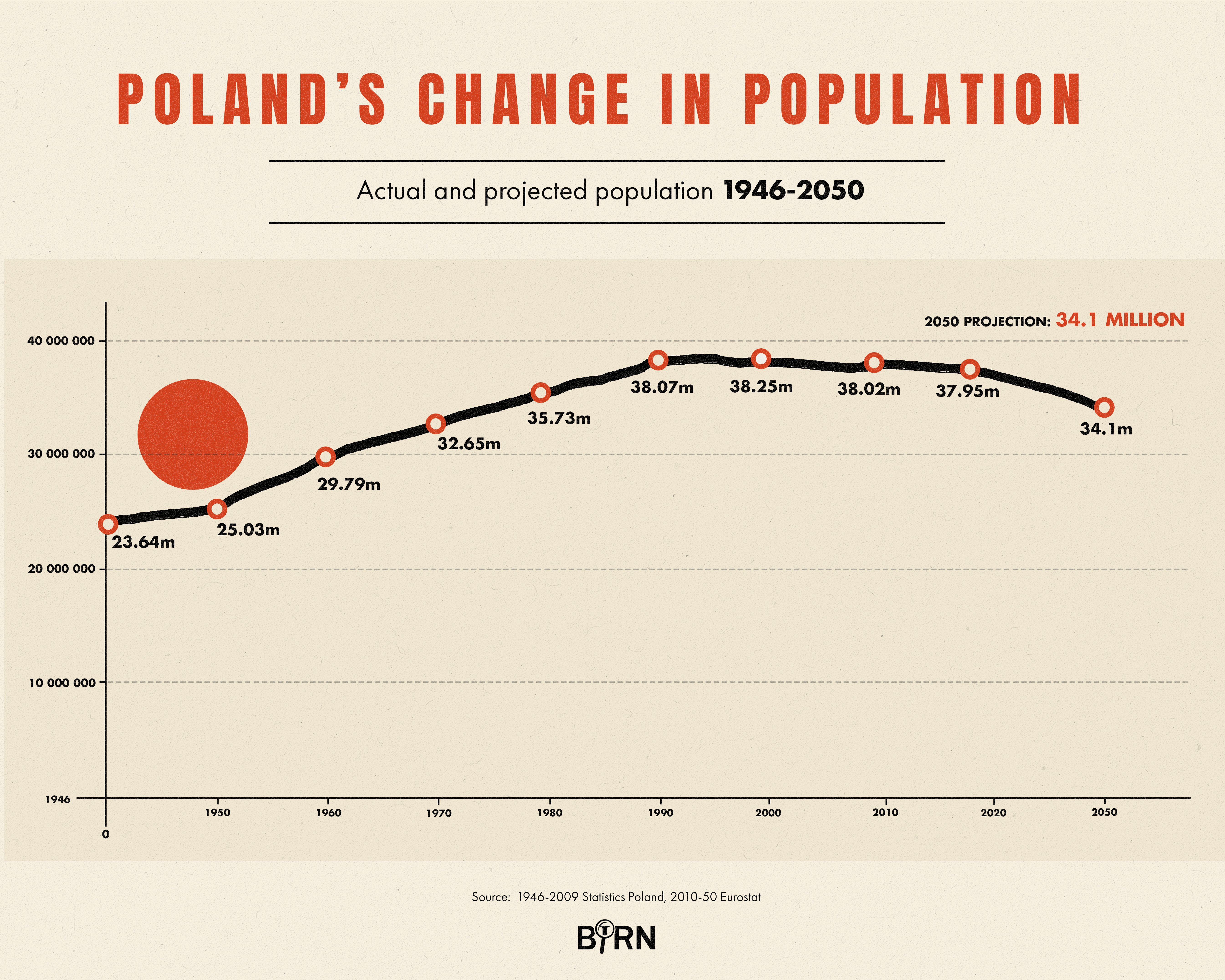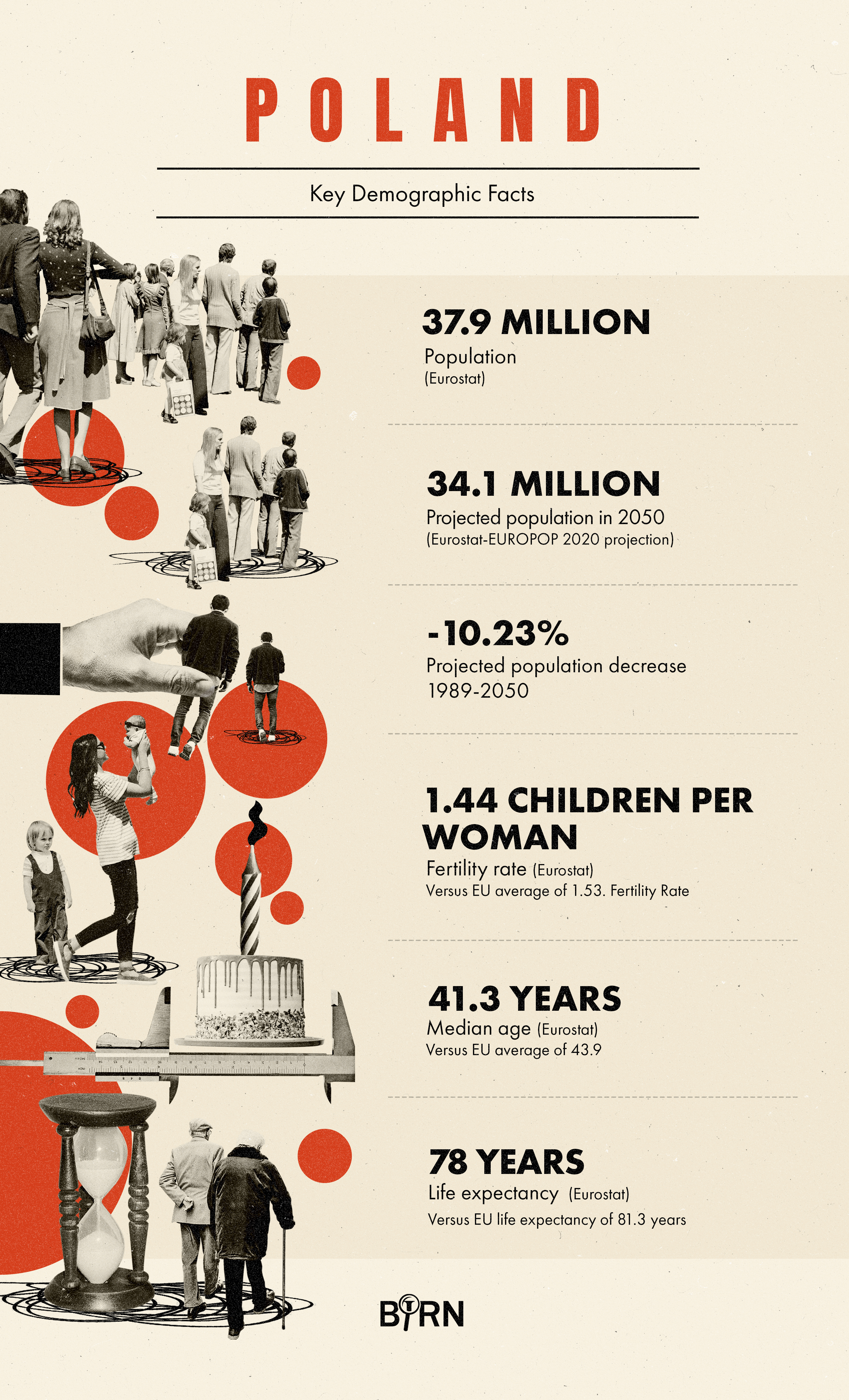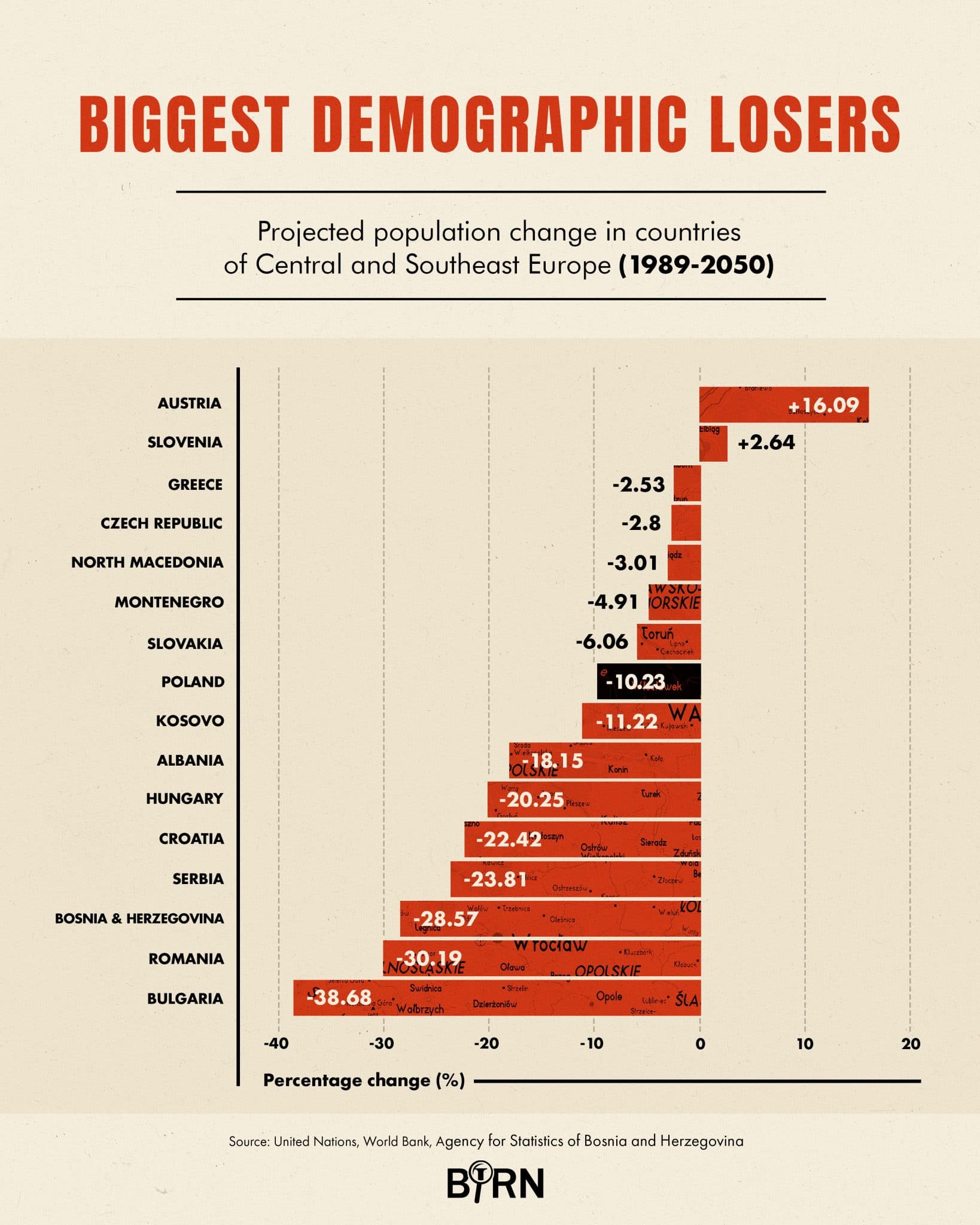It is hoped Poland’s 2021 census, launched on Thursday, will bring clarity to the demographics of a country that is simultaneously experiencing mass emigration and mass immigration.
“Poland has not yet perished…” say the first words of Poland’s national anthem, composed in 1797, when the country had been partitioned and disappeared from the map. “What the foreign force has taken from us, we shall with sabre retrieve!” Today no foreign force threatens Poland, and sabres will not help secure the country’s future. But having more babies definitely could.
In 1946 the first post-war census counted 23.9 million people (see box below). As elsewhere in Europe, the ensuing baby-boom meant that the population grew fast, and it was to peak in 1996 at 38.3 million, though figures vary depending on definitions of who should be counted. On Thursday, Poland begins its 2021 National Census of Population and Housing, which is certain to confirm the more recent trends of a shrinking and ageing population that have left the resident population at an estimated 37.9 million, a figure which excludes most temporary migrants such as Ukrainians.
At current rates, according to Eurostat, the EU’s statistical agency, Poland’s population could have shrunk to 34.1 million by 2050 and to 27.65 million by 2100. The two main reasons for Poland’s falling population are emigration and because Poles are having less children. They are also ageing and the size of the country’s labour force is declining. In all developed countries, governments are tackling this problem by increasing retirement ages, not least because people are living longer and healthier lives. In Poland, the government did the opposite and reduced them.
Recently, the country has been rocked by demonstrations against the effective banning of abortion. The ban was for ideological and religious reasons, and not directly connected with Poland’s low fertility rate. Yet, says Prof Irena Kotowska of the Warsaw School of Economics and one of Poland’s leading demographers, in such a heated and embittered atmosphere it has become virtually impossible “to have a serious and reasonable argument” about anything which touches on people’s private lives. Yet the problem, she says, is that decisions about having children also happen to be “important for us as a society”.
For a country whose population is declining and ageing, encouraging people to have more children has long been an important subject of debate. But, says Kotowska, the government ignores the work of experts like her while opposition politicians will not commit themselves to unpopular, but most likely inevitable, policies such as raising retirement ages again.

Poland’s change in population. Infographic: © Ewelina Karpowiak / Klawe Rzeczy
At the same time, Poland’s politicians indulge in fantasy politics when it comes to the issue of immigration. In the wake of the migrant crisis in 2015-16, at which point Germany took in more than a million refugees and migrants, Poland became locked in a dispute with the European Commission and refused to take in 7,000 of them. Officially it opposes immigration; in fact, as the economy has expanded and labour shortages have developed, it is now home to some 2 million foreigners.
Westward ho!
In many Central and Eastern European countries, populations began to drop very soon after the end of communism in 1989. This was due to the economic collapse of the 1990s, which led to emigration and a sharp drop in the number of children being born. Poland’s population, however, continued to rise until 1996, since which time it has declined slowly. It was only in 2004, when Poland joined the European Union, that emigration really took off. While most EU countries instituted transitional arrangements, meaning that for several years Poles did not have the freedom to move to or work in them, the UK was a major exception amongst the big countries. The numbers who emigrated during this period are stunning. By 2015 there were estimated to be 2.4 million Poles living abroad, most of whom had left since 2004. By 2017 the number of Poles in the UK alone was more than a million.
At the same time, as elsewhere in CEE, Polish fertility rates were dropping sharply while, at the same time, mortality rates were too. In other words, Poles were not just leaving, but those who remained behind were having less children and living longer. In 1950 in Poland, a baby girl could expect to live for almost 62 years and a boy for just over 56. By 1989 those numbers were 75.45 and 66.8 respectively. By 2019, however, life expectancy for women was 81.8 and 74.1 for men. For the EU as a whole, in 2018 those figures were 83.7 and 78.2, so Poles can expect to live even longer in the future. Today, Poland’s median age is 41.3, while for the EU it is 43.9, but Poles are ageing fast. By 2050 Poland’s median age is expected to be 50, the fifth highest in the EU.

Romania key demographic facts. Infographic: © Ewelina Karpowiak / Klawe Rzeczy
In the post-war years the highest number of babies ever born in a single year was in 1955. Then 793,847 babies were born and 261,576 people died, meaning that, without taking any migration into account, the population increased by 532,271. The year 2002 was the first in which there were more deaths than births, but between 2006 and 2012 Poland again had more births than deaths. Every year since, though, Poland has seen more coffins than cradles. In 1950 Poland’s fertility rate was 3.7 children per woman. That rate needs to be 2.1 for the population of a given country to replace itself and it was exactly that in 1989. Since 1998 it has remained below 1.5. In 2003 it had collapsed to 1.23, which is extraordinarily low by any standards, let alone for a people whose identity has traditionally been bound up with Roman Catholicism, which opposes birth control. In 2019 it was 1.44; the average for the EU is 1.53.
In 2020 there were 475,253 deaths and 120,255 more who died than were born. That number of deaths was the highest in any year since the end of the war and was 80,000 higher than average. Officially, COVID-19 deaths only accounted for 28,500 of them, but in fact, thanks to low testing rates and undetected cases, the pandemic is likely to have been responsible for far more. Across the world the first indicators are that, due to the economic uncertainty caused by COVID-19, women are having less children. Poland’s birth rate has been declining for years, but in 2020 Polish women had the least babies since 2003. Since COVID-19 could only account for a small amount of that drop, the figures for 2021 will be more revealing as to the effect of the pandemic.

Biggest demographic losers. Illustration: © Ewelina Karpowiak / Klawe Rzeczy
Quite apart from living longer and having less children, another reason the statistics show that Poles are ageing is because so many younger people have emigrated. By one calculation, 10 per cent more babies would have been born in Poland between 2005 and 2014 if their mothers had not been abroad. According to Jakup Krupa, a Polish researcher and journalist in London, 262,636 Polish babies have been born in the UK since 2005. The real number is even higher, though, because those born to one parent with British citizenship may not be recorded as Polish even if that British parent also has Polish citizenship. Not only is the number of Anglo-Polish babies being born “a lot”, says Krupa, but it means that Polish women in the UK, and probably other foreign countries too, have more children than their counterparts at home.
500+ for families
High emigration and low fertility rates have been a concern for Polish governments for years. Better standards of living are the main way to combat the former and indeed, as Poland has become wealthier and salaries have gone up, formerly high rates of emigration have dropped. Persuading Polish women to have more babies seems to be far more difficult than growing the economy, though. According to Kotowska, 2008 was the “turning point” in government thinking about increasing fertility. Longer and more flexible maternity and parental leaves were instituted along with other parent-friendly reforms. Extra financial support for families was introduced, but expenditure on family and child allowances remained modest.
In 2016 the populist and socially conservative Law and Justice party (PiS), which blamed its predecessors in government for the demographic situation in the country, came up with a radical new pro-natality plan. In a bid to encourage families to have more children, it launched the Family 500+ scheme, through which families receive 500 zlotys (111 euros) a month for every second and subsequent child up to the age of 18. For the next two years the number of births increased, but then fell back again. The number of births in 2020 was the lowest since 2003. Along with other policy measures, this financial help seems to have impressed families who were already planning to have more children and, uncertain how long the policy would be in place thinks Kotowska, they rushed to have them. In fiscal terms the sums involved are “really huge”, she says, but after that these transfers simply “did not encourage people to become parents.”
The 500+ policy appears to have had other effects, though. It has been of genuine help to lower income families, which in turn has cemented a loyal core of PiS voters. It has also enabled tens of thousands of mainly younger women to stop working, thus exacerbating labour shortages. Declining birth rates and emigration mean that the number of Poles of working age in the country is shrinking. This was one reason that in 2012 retirement ages were set to gradually increase for both men and women to the age of 67. In 2016, however, PiS scrapped this reform, returning retirement ages to what they had been before – 60 for women and 65 for men. Although this move was popular, it means that in future pensioners will receive smaller pensions and the country already has a significantly smaller labour force. From 2015 to 2050 the number of people aged 15-64 is set to decline by 28 per cent and the number of people aged 65 and over will rise by 83 per cent.
The ins and outs
While birth rates in Western European countries have also declined, the population of many of them has simultaneously increased thanks to immigration, much of it from CEE countries like Poland. What makes Poland different, however, is that it has recently become a country of mass emigration and mass immigration – at the same time. It was clear to policymakers as far back as 2007 that Poland would soon be facing labour shortages and so immigration rules were changed, making it easier for employers to take on foreigners, Ukrainians in particular. While their numbers began to increase slowly at first, especially in construction and agriculture, replacing Poles who were going westwards, it was only with the Russian intervention in Ukraine in 2014 that Ukrainian numbers really began to shoot up. By luck rather than design, this was also precisely when labour shortages due Polish emigration really began to bite. Most Ukrainians come on short-term contracts rather than settle like Poles abroad and, as it was easy and legal for them to come to work, it was assumed that there were few in the country illegally and hence uncounted. In the last few years, it was commonly estimated that that there might be about a million Ukrainians in Poland at any one time, depending especially on the agricultural calendar.
However, research done at the beginning of the COVID-19 pandemic, collating data for the first time from nine databases, found that previous assumptions were wide of the mark. In June 2020 the Polish statistical agency published estimates for the number of foreigners in the country. According to this research, there had been 2.2 million at the end of February, of whom 1.39 million were Ukrainian. There were, in fact, “many more Ukrainians than we thought,” says Marta Jaroszewicz, of Warsaw University’s Centre of Migration Research. The second biggest number of foreigners were from Belarus, other former Soviet states, India, Vietnam and Nepal. Then, in the first two months of the pandemic, the authorities recorded a drop of 223,000 foreigners or 10 per cent.
But why are there so many more foreigners, and especially Ukrainians, in Poland than was previously thought? According to Jaroszewicz, one reason could be because the country’s complicated and time-consuming bureaucracy makes it hard to register. The second reason is that employers are happy to pay workers illegally in cash and some of them in turn want to avoid paying tax and health insurance. However, Jaroszewicz suspects that an increasing number of Ukrainians are no longer happy to commute back and forth, and are settling permanently and bringing their families.
New data from the UK, however, reveals some interesting facts. With Brexit, those EU citizens who wished to stay had to register under the EU Settlement Scheme. In June 2020 the Office of National Statistics (ONS) estimated that there were 815,000 Poles in the UK. As this number is 200,000 less than in 2017, the year after the Brexit referendum, it implies some have left. To date, we do not know how many Poles have returned from abroad since the beginning of the pandemic. After the UK, the second largest number of Poles abroad is in Germany where, at the end of 2019, there were officially 862,535, making Poles the second largest foreign community after Turks.
Some may have acquired British citizenship and are no longer counted as Poles for that reason, but in fact the number of Poles who have become citizens is surprisingly low. From the beginning of 2007 until October 2020 only 58,667 Poles had acquired citizenship, says Krupa, who has crunched the numbers. He attributes this low figure to the fact that, as the process can cost up to 1,500 pounds per person, it is just too expensive for most families. According to the British data, by the end of December 2020 there were 854,630 “concluded applications” by Poles to stay in the UK and there were still six months left for people to apply. Although those numbers don’t mean that precisely that number of individuals applied, they do show what Krupa and community leaders have long suspected: that the ONS has long underestimated Polish numbers in the UK. If you add together Poles who have come to the UK at different times, says Krupa, plus those born to the generation who came during or just after the war, “it is fair to say there’s somewhere between 1 million and 1.5 million” Poles in the UK.
Poland’s 2021 census, which is being carried out between April 1 and June 30, is certain to confirm the trends of a shrinking and ageing population, but hopefully it will also go some way to yielding clarity where there is none today. The census of March 21 in England and Wales should also help with regard to the real number of Poles in Britain. If there are far more Poles in the UK than had hitherto been thought and, at the same time, several hundred thousand more Ukrainians and others in Poland, then how many people actually live in Poland and how many are citizens? With answers to these questions, we will be able to understand to what extent Poland is becoming like a rich western country, in the sense that it is solving its demographic and some of its social problems through immigration. Polish women look after elderly Germans and Britons, for example, and now Ukrainians increasingly take care of the carers’ parents.
The opinions expressed are those of the author only and do not necessarily reflect the views of BIRN or ERSTE Foundation.
First published on 1 April 2021 on Reportingdemocracy.org, a journalistic platform run by the Balkan Investigative Reporting Network. The article was produced within the framework of the Europe’s Futures project.
This text is protected by copyright: © Tim Judah. If you are interested in republication, please contact the editorial team.
Copyright information on pictures and graphics are noted directly at the illustrations. Cover picture: Illustration: © BIRN